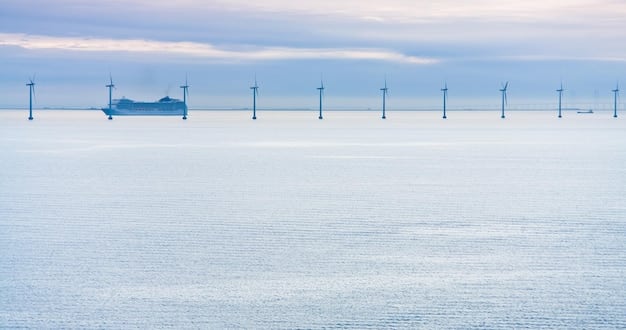Wave Energy: Powering the US Coastline Beyond Solar by 2030

Beyond solar panels, wave energy technologies are emerging as a promising renewable resource for the US coastline, potentially providing clean, sustainable power by 2030 through innovative devices that harness the ocean’s kinetic energy.
As the quest for sustainable energy intensifies, the focus is shifting beyond solar panels to explore the vast, untapped potential of wave energy. Imagine a future where the US coastline is powered by the rhythmic motion of the ocean.
The Untapped Potential of Wave Energy in the US
Wave energy represents a significant opportunity to diversify the US energy portfolio. Unlike solar and wind, which are intermittent and geographically limited, wave energy is more predictable and consistent, particularly in coastal regions. Let’s delve into why wave energy is an attractive renewable source.
Why Wave Energy? Exploring the Benefits
Harnessing wave energy presents several compelling advantages. Its reliability, high energy density, and minimal land use make it a strategic resource for coastal communities.
- Predictability: Wave patterns are more predictable than solar irradiance or wind speeds, allowing for better grid integration.
- Energy Density: Water is far denser than air, meaning waves carry significantly more energy than wind. This leads to higher energy yields from smaller devices.
- Minimal Land Use: Wave energy converters (WECs) can be deployed offshore, minimizing visual impact and competition for land resources.
Wave energy can contribute to energy independence, reduce carbon emissions, and spur economic growth in coastal areas. It offers a resilient energy source that complements other renewables.

Diverse Wave Energy Technologies: A 2030 Outlook
Various wave energy technologies are currently being developed and tested, each with unique designs and operational principles. By 2030, several of these technologies are expected to be commercially viable and deployed along the US coastline.
Oscillating Water Columns (OWCs)
OWCs are shore-based or nearshore structures that use the motion of waves to compress air, which then drives a turbine to generate electricity. They are relatively simple in design and can be integrated into coastal defenses.
Point Absorbers
Point absorbers are floating devices that capture energy from wave motion. They can be deployed individually or in arrays, converting the kinetic energy of waves into electrical power.
Overtopping Devices
Overtopping devices capture waves in a reservoir and then release the water through turbines to generate electricity. These devices can be integrated into breakwaters or coastal defenses.
Challenges and Opportunities: Overcoming Market Barriers
While wave energy holds immense potential, its widespread adoption faces several challenges. Addressing these challenges is essential to unlock the full potential of wave energy in the US by 2030.
Technical and Environmental Challenges
Developing robust and reliable WECs that can withstand harsh marine environments poses a significant technical challenge. Environmental concerns, such as impacts on marine life and coastal ecosystems, must also be carefully addressed.
Economic and Regulatory Barriers
High initial capital costs, limited access to financing, and complex regulatory frameworks hinder the commercialization of wave energy technologies. Streamlining permitting processes and providing financial incentives can accelerate deployment.
Public Perception and Social Acceptance
Gaining public support and ensuring social acceptance are crucial for the successful deployment of wave energy projects. Addressing concerns about visual impacts, noise, and potential disruptions to coastal activities can foster community buy-in.

The Role of Government and Industry Collaboration
Government support, industry collaboration, and research and development (R&D) are critical to advancing wave energy technologies. Strategic partnerships and investments can accelerate innovation and deployment.
Policy Incentives and Regulatory Frameworks
Government policies and regulatory frameworks play a vital role in fostering a supportive environment for wave energy development. Feed-in tariffs, tax credits, and streamlined permitting processes can incentivize investment and deployment.
Research and Development Initiatives
Investing in R&D is essential to improve the performance, reliability, and cost-effectiveness of wave energy technologies. Collaborative research programs involving universities, national laboratories, and industry partners can drive innovation.
Public-Private Partnerships
Public-private partnerships can leverage the expertise and resources of both government and industry to accelerate the commercialization of wave energy technologies. These partnerships can facilitate technology demonstration, pilot projects, and infrastructure development.
Case Studies: Global Wave Energy Projects
Examining successful wave energy projects worldwide provides valuable insights and lessons learned for the US. These case studies showcase the potential of wave energy to generate clean electricity and support coastal communities.
Portugal’s Aguçadoura Wave Farm
The Aguçadoura Wave Farm in Portugal was one of the first commercial-scale wave energy projects. Although it faced technical challenges, it demonstrated the feasibility of generating electricity from wave energy.
Scotland’s European Marine Energy Centre (EMEC)
EMEC in Scotland is a leading test center for wave and tidal energy technologies. It provides a real-world environment for developers to test and validate their devices.
Australia’s Albany Wave Energy Project
The Albany Wave Energy Project in Australia is a grid-connected wave energy plant that uses CETO technology. It demonstrates the potential of wave energy to provide clean power and support desalination.
Future Outlook: Wave Energy’s Contribution to the US Energy Mix
Wave energy has the potential to play a significant role in the US energy mix by 2030, contributing to energy security, reducing carbon emissions, and creating economic opportunities. With continued innovation and investment, wave energy can become a mainstream renewable energy source.
Projected Growth and Deployment Scenarios
Various scenarios project significant growth in wave energy deployment in the US over the next decade. Factors such as technology advancements, policy support, and market demand will influence the pace of deployment.
Technological Advancements and Cost Reductions
Ongoing R&D efforts are focused on improving the performance, reliability, and cost-effectiveness of wave energy technologies. Innovations in materials, design, and control systems are expected to drive down costs and enhance efficiency.
Integration with Existing Energy Infrastructure
Integrating wave energy into existing energy infrastructure, such as transmission grids and coastal power plants, is crucial for maximizing its impact. Upgrading infrastructure and developing smart grids can facilitate the seamless integration of wave energy.
| Key Point | Brief Description |
|---|---|
| 🌊 Wave Energy Potential | Vast and consistent renewable energy source for US coastlines. |
| ⚙️ Diverse Technologies | Includes Oscillating Water Columns, Point Absorbers, and Overtopping Devices. |
| 🤝 Collaboration is Key | Government, industry, and research partnerships drive innovation. |
| 🌎 Global Examples | Projects in Portugal, Scotland, and Australia provide valuable insights. |
Frequently Asked Questions
▼
Wave energy is more predictable and has a higher energy density than solar. Waves also require minimal land use, making it a strategic resource for coastal regions lacking space for large solar farms.
▼
The Pacific Northwest and the Atlantic coast offer the highest wave energy potential due to consistent wave climates. Studies show these regions can support significant wave energy projects by 2030.
▼
Potential risks include noise pollution, habitat disruption, and entanglement of marine life. Careful site selection and mitigation strategies can lessen these impacts, ensuring responsible development.
▼
Wave energy converters utilize various mechanisms. Oscillating Water Columns compress air to drive turbines, while Point Absorbers capture wave motion to generate electricity. Overtopping devices release water through turbines.
▼
Increased incentives, streamlined permitting, and long-term funding for R&D are essential. Legislation supporting renewable energy standards can guarantee the uptake of wave energy in multiple states.
Conclusion
As we look to a future powered by renewable energy, wave energy stands out as a promising resource for the US coastline. Addressing the challenges and seizing the opportunities through strategic collaboration and innovation will pave the way for wave energy to become a significant contributor to the nation’s energy mix by 2030.





